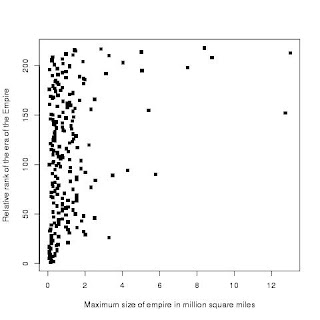The list of largest Empires at Wikipedia tries to provide an unbiased list of empires, their size and the approximate time during which these empires existed. Even though the very definition of the term "empire" is fraught with controversies, an operational definition that one might accept would involve large tracts of land, resources and people that have been brought under the control of some sort of central political entity.
Obviously, over time the world has become more connected and has required larger regions to be under a single dominion to be considered an empire. In the distant past, the control of a collection of tribes might have been enough to be considered an empire. Overtime, this has grown to require the control of more than one continent. Thus, in a way the very way that empires have been defined, requires that they become larger over time. So, one would expect a positive correlation between the size of the empires and the time period in which they have existed.
We use the list compiled by wikipedia from various scholarly sources to test this hypothesis. The list accessed on November 2015 had 218 empires with a mean maximum size of 1.161 square miles, with a minimum of 0.060 sq.miles (old kingdom Assyria in 1730 BC) and a maximum of 13 sq.miles (British Empire as measured in the year 1922). We find a significant positive correlation (pearson's correlation coefficient r= 0.29, p-value = 1.329e-05) between the size of empires and the "era" in which they happened reach their zenith ( also see figure below). The correlation is not driven by a few outliers and still shows a strong pattern when restricted to empires smaller than 0.5 million square miles (r=0.16) or 0.1 million square miles (r=0.39).
This suggests that empires have obviously become larger over time. It can also be seen that the largest of them all, the British Empire covered ~23% of the world's land area. One can wonder (when modelling the process is beyond..), if this is some sort of a limit on how big an empire can get before running into trouble. Keith Jeffrey in his book "The British Army and the Crisis of Empire, 1918-22: page 160", echoes this very thought expressed by 'Boney' Fuller when he said "we cannot increase the size of the army to fit the Empire; consequently there is only one thing we can do, namely, reduce the size of the Empire to fit our army".
The age of empires has interesting patterns that are potentially driven by complex processes. Would this correlation exist on a planet that completely lacked geographical barriers? How different would this pattern be if technology had not grown as fast as it has on our blue sphere?
